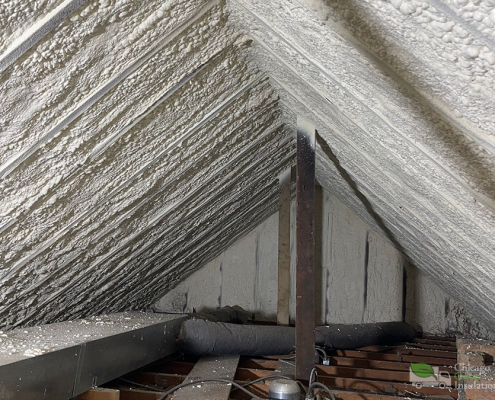Top 10 Things to Know When Fixing Issues with Your Home

- Assessment: Begin by assessing your home’s current insulation and identifying areas that need improvement. This will help you prioritize which areas to insulate first. At Chicago Green Insulation we charge $500 for a full home analysis of an existing home that is not undergoing construction. This evaluation will use Building Performance Institute standards to find the shortcomings and failures of the “thermal envelope” and where you have the biggest opportunities to make a difference. At the time of the evaluation, it is important for you to know the goal/ problem that needs to be solved and any upcoming medications to your home, and the way you use it. Is Mom/ Dad moving in? Are the kids moving out? Is the basement a future income property for you and an “In Law Suite” for the rest of the year? Are you going to finish your attic, put on an addition, be aware of these things, and make a list for the day our auditor arrives so you can discuss them? The $500 for the audit will be applied toward the scope of work you hire us to do in your home! It is also eligible for a $150 tax credit at the end of the year via the Inflation Reduction Act
- Types of Insulation: Research different insulation types suitable for your home, such as spray foam (Open or Closed Cell), blown-in insulation (Blown-in loose cellulose or fiberglass or dense pack), or batt insulation. Think of this as a “Good, Better, Best” scenario. More fiberglass batts in your attic is “good” (loose fiberglass is not as good), as long as you reach the 18-24” depth but if you do that the first step is to air seal all can lights, all bathroom vents must be vented to the outside and then the results will be “good”. If you do cellulose, it is “better” than fiberglass but still requires the air sealing before adding the new 16” or so of insulation to the 2021 code requirement of R60 in your attic. In walls, the same options exist. The vast majority of existing walls have fiberglass and are not doing their job so it does not make sense to put back the same material that was not working. If fiberglass is your only option, please be smart and plan to air-seal the cavity with expanding foam at every seam, nail hole or gap in the cavity before putting in that batt. If cellulose is your thought, the nice part of that is that you can install it via a hole in the drywall or even possibly the plaster as long as you have 3” or more cavity space. (We do this if needed!) If the wall is open, foam is the best option as it is both an air seal and insulation. If code officials are involved, you may not have any choice as the new R-value requirement in a wall is R30 which is not possible with fiberglass or cellulose.
- R-Values: Understand R-values, air sealing, convection, and conductive heat flow and the impact. More is not always better but, it is a choice that you make in the process. Every insulation material comes with an R-value, which is the “resistance to conductive heat flow”. Wood has an R-value of 1 per inch., which indicates the insulation’s effectiveness. Chicago’s climate may require higher R-values to ensure sufficient insulation against the cold.
- Air Sealing: Proper air sealing is crucial to the overall performance of a home during the worst of the winter or summer. The average American home has enough holes in the house that if you add all the tiny gaps, cracks, and openings that allow drafts, you have a 4-square-foot opening in the side of your home. It is like leaving a window open and wondering why the furnace is not keeping you warm… Sealing these areas before insulating will enhance energy efficiency! Insulating with foam will do both air sealing and insulating!
- Moisture Control: Address any moisture issues before insulating. Improper ventilation of humidity can trap moisture and lead to mold growth in the home. Consider using insulation materials that have moisture-resistant properties while still following all rules regarding the ventilation of moisture.
- Vapor Barriers: Depending on the insulation type and your climate, you may need vapor barriers to prevent moisture from penetrating insulation and causing damage. On the exterior, you will want to have rain shields, proper tuck pointing, moisture barrier paints, etc…. Keeping your structure dry is one of the most important tasks you tackle with home ownership.
- Ventilation: Ensure proper ventilation to prevent moisture buildup in insulated areas. Inadequate ventilation can lead to issues like condensation and reduced insulation effectiveness. When building/ renovation the phrase is Build it tight, ventilate right! You will want to consider ERV’s/ HRV’s or makeup air of another sort on your forced air system.
- Professional Installation: Insulating an older home effectively requires expertise. Hiring a professional insulation contractor who understands the intricacies of older structures is advisable. When tackling these tasks you will want to have and use thermal cameras to understand where the construction should be done and the knowledge to know that this or that is the most important area.
- Local Codes: Check local building codes and regulations related to insulation. Complying with these codes ensures your insulation meets safety and efficiency standards. Your local code officials in the suburban communities of Chicago will take calls and offer you insight who the contractors that work in their communities that have the best reputation, give them a ring, and ask for suggestions. For Chicago Green Insulation, we have done spray foam insulation training at most of these offices over the past two decades so they know we do work by the book.
- Cost vs. Savings: While insulating can lead to energy savings, consider the upfront cost and potential long-term benefits when making your decision. In renovation work, it is possible to reduce usage by as much as 90% from existing uninsulated space. This is not common, most contractors don’t have the capacity to discuss these deep energy retrofits but if you are ready to tackle a deep energy renovation give us a call!
When doing this work it is important to know all the options for rebates and incentives, this is the best site for that! https://www.rewiringamerica.org/
Remember that insulating an older home is a tailored process. Consulting with insulation experts who have experience with older homes can provide valuable insights and guidance specific to your situation.

 With ten years of experience selling spray foam insulation in Chicago, Tom Decker is THE person to call and the Chicago Green Insulation is the organization to hire when you are looking for top notch quality and performance as well as someone who can deal with the needs of code officials, home owners and general contractors. Call the others in Chicago, if you are interested in the cheapest price, call Chicago Green Insulation if you are interested in using your dollars to make Chicago a better city for all of us!
With ten years of experience selling spray foam insulation in Chicago, Tom Decker is THE person to call and the Chicago Green Insulation is the organization to hire when you are looking for top notch quality and performance as well as someone who can deal with the needs of code officials, home owners and general contractors. Call the others in Chicago, if you are interested in the cheapest price, call Chicago Green Insulation if you are interested in using your dollars to make Chicago a better city for all of us!

 Chicago Green Insulation
Chicago Green Insulation Chicago Green Insulation
Chicago Green Insulation Chicago Green Insulation
Chicago Green Insulation Chicago Green Insulation
Chicago Green Insulation


 Chicago Green Insulation
Chicago Green Insulation